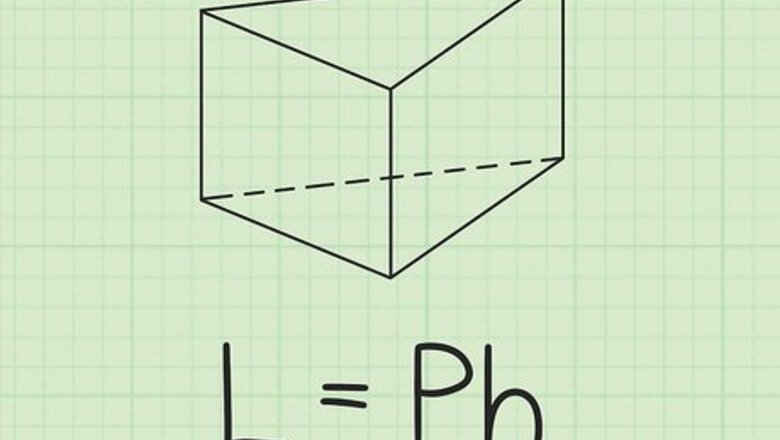
views
X
Research source
In a triangular prism, the bases are triangles. A triangular prism also has three lateral sides. To find the surface area of triangular prism, you first need to find the area of the lateral sides, then you need to find the area of the bases. Finally, you need to add these two areas together to find the total surface area. These steps are represented by the formula
surface area
=
L
+
2
B
{\displaystyle {\text{surface area}}=L+2B}
, where
L
{\displaystyle L}
equals the lateral area of the prism and
B
{\displaystyle B}
equals the area of one base.
Finding the Lateral Area
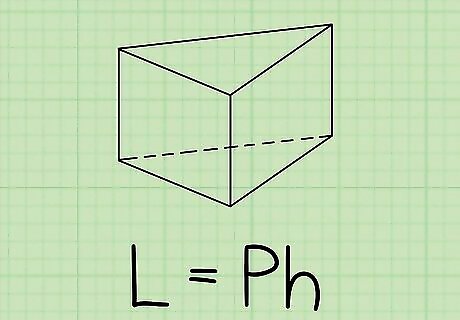
Write down the formula for finding the lateral area of a triangular prism. The formula is L = P h {\displaystyle L=Ph} L=Ph, where L {\displaystyle L} L equals the lateral area of the prism, P {\displaystyle P} P equals the perimeter of one base, and h {\displaystyle h} h equals the height of the prism. The lateral area of a prism is the surface area of all sides, or faces, that are not the base.
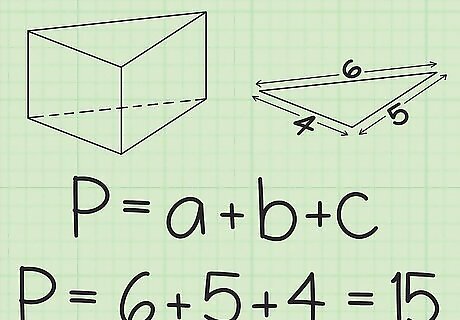
Calculate the perimeter of one base. The base is a triangle, so it will have three sides. The area of the perimeter of a triangle is Perimeter = a + b + c {\displaystyle {\text{Perimeter}}=a+b+c} {\text{Perimeter}}=a+b+c, where a {\displaystyle a} a, b {\displaystyle b} b, and c {\displaystyle c} c are the length of each side of the triangle. It doesn’t matter which base you use to calculate, because the two bases of a prism are congruent. For example, if the base has three sides measuring 6 cm, 5 cm, and 4 cm, to calculate the perimeter, you would add up all three sides: 6 + 5 + 4 = 15 {\displaystyle 6+5+4=15} 6+5+4=15. So, the perimeter of one base is 15 cm.
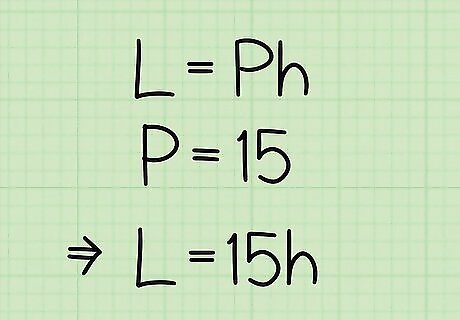
Plug the perimeter into the lateral area formula. Make sure you substitute for the variable P {\displaystyle P} P in the formula. For example, L = 15 h {\displaystyle L=15h} L=15h.
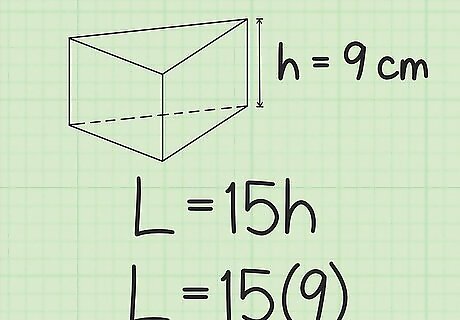
Plug the height of the prism into the lateral area formula. The height of the prism is the same as the length of the side of any lateral face that is not connected to the base. Usually (but not always) this will be the longer side of the lateral face. For example, if the height of the prism is 9 cm, your formula will look like this: L = 15 ( 9 ) {\displaystyle L=15(9)} L=15(9).
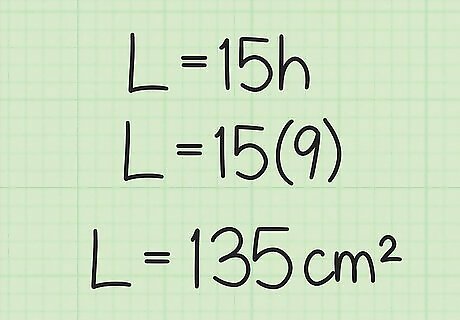
Multiply the perimeter of one base with the height of the prism. The result will give you, in square units, the lateral surface area of the prism. This is the first value you need to find the total surface area of the prism, so set this value aside while you calculate the area of the base. For example, 15 ( 9 ) = 135 {\displaystyle 15(9)=135} 15(9)=135, So, the lateral surface area of the prism is 135 square centimeters.
Finding the Area of the Base
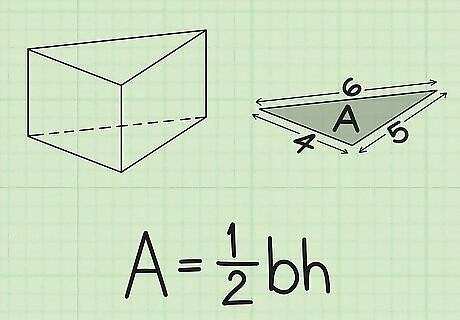
Set up the formula for the area of a triangle. Since the bases of a triangular prism are triangles, you will use this formula to calculate their area. The formula for the area of a triangle is A = 1 2 b h {\displaystyle A={\frac {1}{2}}bh} A={\frac {1}{2}}bh, where A {\displaystyle A} A equals the area of the triangle, b {\displaystyle b} b equals the base of the triangle, and h {\displaystyle h} h equals the height of the triangle. This is the most common way to calculate the area of a triangle. If you don’t know the height of the triangle, you can also calculate the area using the length of the triangle’s three sides. You only need to find the area of one base, since the two bases of a prism are congruent, and will therefore have the same area.
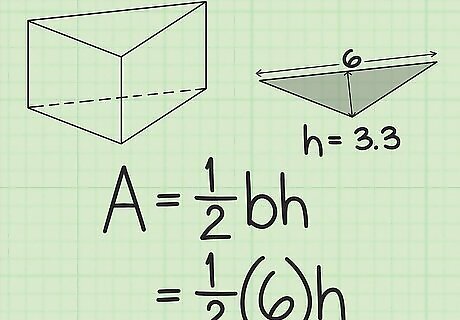
Plug the base of the triangle into the formula. Don’t confuse the base for another side of the triangle. The base is the side perpendicular to the height. For example, if the base of the triangle is 6 cm, your formula will look like this: A = 1 2 6 h {\displaystyle A={\frac {1}{2}}6h} A={\frac {1}{2}}6h.
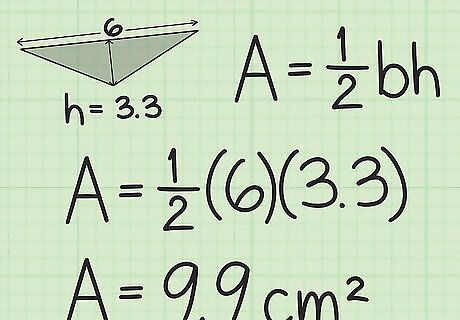
Plug the height of the triangle into the formula. Multiply the base by the height. Then, take half of this value. This will give you the area of the base, in square units. This is the second value you need to calculate the total surface area of the prism. For example, if the height is 3.3 cm, then your calculations will look like this: A = 1 2 6 ( 3.3 ) {\displaystyle A={\frac {1}{2}}6(3.3)} A={\frac {1}{2}}6(3.3) A = 3 ( 3.3 ) {\displaystyle A=3(3.3)} A=3(3.3) A = 9.9 {\displaystyle A=9.9} A=9.9So, the area of the base is 9.9 square centimeters.
Finding the Surface Area
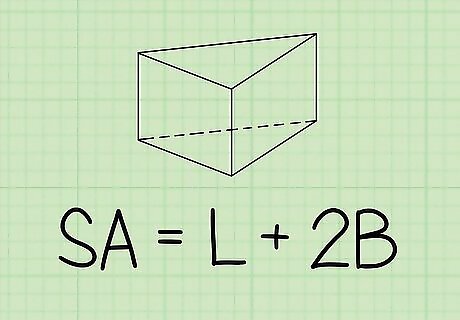
Set up the formula for finding the surface area of a prism. The formula is S A = L + 2 B {\displaystyle SA=L+2B} SA=L+2B, where S A {\displaystyle SA} SA equals the surface area of the prism, L {\displaystyle L} L equals the lateral area of the prism, and B {\displaystyle B} B equals the area of one base.
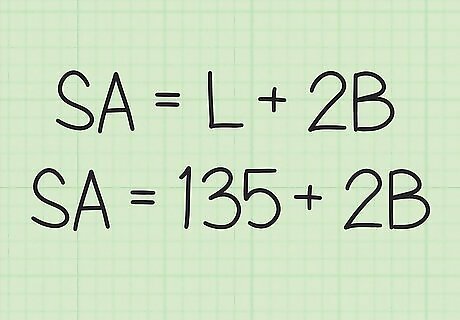
Plug the lateral area into the formula. This is the surface area of all sides of the prism that are not the base. You should have calculated this previously. Make sure that you substitute the lateral area for the variable L {\displaystyle L} L. For example, if the lateral area of your triangular prism is 135 square centimeters, your formula will look like this: S A = 135 + 2 B {\displaystyle SA=135+2B} SA=135+2B.
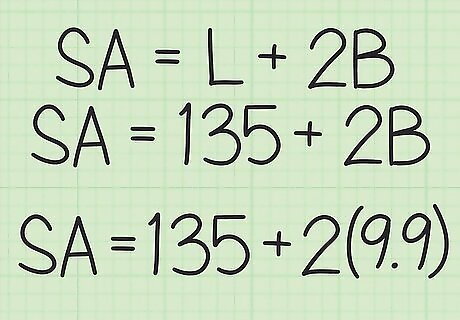
Plug the area of one base into the formula. Make sure you use the area of just one base, not the total area of both bases combined. Substitute the base area for the variable B {\displaystyle B} B. For example, if the area of one base of your prism is 9.9 square centimeters, your formula will look like this: S A = 135 + 2 ( 9.9 ) {\displaystyle SA=135+2(9.9)} SA=135+2(9.9).
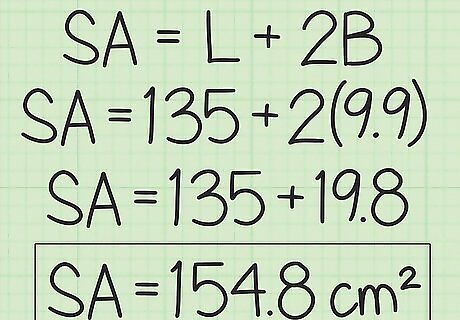
Complete the calculations. Multiply the area of the base by 2, then add the lateral area. This will give you the total surface area, in square units, of your triangular prism. For example: S A = 135 + 2 ( 9.9 ) {\displaystyle SA=135+2(9.9)} SA=135+2(9.9) S A = 135 + 19.8 {\displaystyle SA=135+19.8} SA=135+19.8 S A = 154.8 {\displaystyle SA=154.8} SA=154.8So, the surface area of a triangular prism with a base having sides measuring 6, 5, and 4 centimeters in length, and a height measuring 9 centimeters in length, has a surface area of 154.8 square centimeters.

















Comments
0 comment